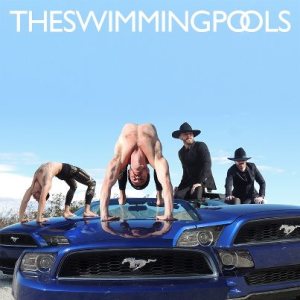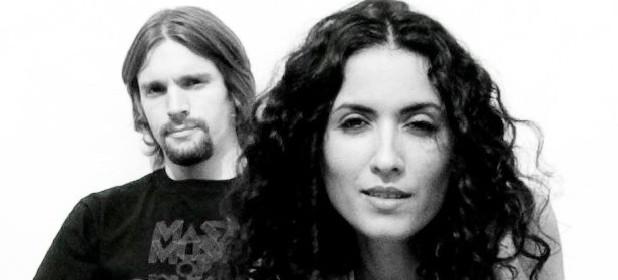The Mast represents one of the more exiting young bands working the Brooklyn indie scene these days with their unique brand of moody, percussive, electronic pop reminiscent yet distinct from acts like School of Seven Bells, Nite Jewel, and A Hundred in the Hands. I have seen the Mast live a couple of times in the last few months, and their sound seems to be quickly evolving as they become ever more popular with New York City area audiences. Musical evolution appears to be a consistent strategy for the Mast, as singer Haale and percussionist Matt Kilmer have transformed their sound from world music influenced rock tunes (under the name Haale), to percussion and guitar-based pop, to a fully electronic dance-oriented sound within which they are currently working. The duo is now spending a great deal of time recording as they prepare to release a second album, but they were kind enough to take some time to meet with me after their show a few weeks ago at Union Pool in Brooklyn. Amidst all of this rapid and dramatic change, I asked the two artists to discuss their current direction and what they envision for the future of the Mast over margaritas and chicken wings at a Cajun restaurant (just joking – we talked outside in the cold for about twenty minutes).
Their responses raised some provocative questions about the nature of indie rock performance compared to other musical genres and how alternative performance styles, particularly those emphasizing the physical, might be successfully incorporated.
Thinking of electronic-based bands that have added to their lineup for live shows, such as Chairlift, I asked Haale and Kilmer if they have considered expanding into a larger ensemble of performers – especially given the rigorous work during their live set necessary to achieve the heavily layered electronic sounds they produce. Haale’s reply surprised me – “Yeah, I would like to include some live dancers.” This unexpected response left me wondering about the propriety of the physical in indie rock. I love live music, however, my motivation for consuming it rarely relies on the actual physical appearance of the artists (except for maybe the Dum Dum Girls show I saw last year, and that had more to do with skirt length) and I have little interest in the sort of pop music heavily dependent upon representations of sexuality as a sales strategy (R&B dance artists like Beyoncé Knowles and squeaky clean-boy teen pop bands One Direction, for instance). Incorporating dance or other physical tropes into indie musical performance is an idea I probably would never have considered were it not for Haale’s comment. In any case, it would seem that incorporating something like dance successfully in indie rock without completely alienating its hipster, cooler-than-cats audience is first and foremost a question of properly proportioning the physical and the musical within the performance.
Not too long ago, for a couple of years, I lived in a Central Asian country called Kazakhstan (don’t ask why). One of the more fascinating events I experienced there (on several occasions) was to watch the performance of traditional Chechen dancing. The dances were so engaging largely because of how they implied gender relations through the movements of the performers (who were usually teenagers). The young men danced erratically, always seeming to act with spontaneity and conveying a coarse, masculine tone. Simultaneously, young women fluttered on the balls of their feet circularly around male partners – never wavering from their companions, but also maintaining distance from the brutish physicality expressed by the young men. Traditional Chechen music also routinely accompanied these dances, aggressively performed with a stringed instrument called a balalaika, perfectly supporting the actions and mood of the male dancers. Certainly the union of dance and music in this cultural context seems natural, even though the physical remains at the forefront of the performance, it relies heavily on the musical element as accompaniment. Conversely, acts like Beyoncé and One Direction provide eye-candy visuals, yet their members are principally singers with their physical performances taking a back seat to music and lyrics. Indie rock as a genre usually emphasizes the artists’ music over their physical appearances or movements – how then might the explicitly physical be most appropriately proportioned as an integral element of indie rock performance?
The dances were so engaging largely because of how they implied gender relations through the movements of the performers (who were usually teenagers). The young men danced erratically, always seeming to act with spontaneity and conveying a coarse, masculine tone. Simultaneously, young women fluttered on the balls of their feet circularly around male partners – never wavering from their companions, but also maintaining distance from the brutish physicality expressed by the young men. Traditional Chechen music also routinely accompanied these dances, aggressively performed with a stringed instrument called a balalaika, perfectly supporting the actions and mood of the male dancers. Certainly the union of dance and music in this cultural context seems natural, even though the physical remains at the forefront of the performance, it relies heavily on the musical element as accompaniment. Conversely, acts like Beyoncé and One Direction provide eye-candy visuals, yet their members are principally singers with their physical performances taking a back seat to music and lyrics. Indie rock as a genre usually emphasizes the artists’ music over their physical appearances or movements – how then might the explicitly physical be most appropriately proportioned as an integral element of indie rock performance?
Haale’s comment was well-timed for such considerations, as I spent some of the evening before our discussion watching the singer for opening act, TheSwimmingPools, transform his set into an entirely physical performance. TheSwimmingPools – composed of Christophe Doloire and Daniel Smith – lay out some bass heavy, electronic tunes, which are completely overwhelmed by Smith’s stage and floor show. Through massive contortions, prancing to and fro on stage, and jumping onto the floor to engage the audience with some in your face gyrating, the guys from TheSwimmingPools certainly managed to send a charge through the crowd. Smith has suggested that he and Doloire are interested in pushing gay sexuality in a very physical way to their audiences, however (in spite of the ambitious and brazen nature of TheSwimmingPools show), as an indie rock consumer, music quality resoundingly trumps showmanship. So what concerns me the most with employing the explicitly physical as an element of indie rock performance is the extent to which it transforms musical performance into a spectacle of bodies where the actual music receives much less of an emphasis (certainly one of the primary limitations to girl or boy dance bands that rely overwhelmingly on good looks and dance moves rather than the production of high-quality music).
Through massive contortions, prancing to and fro on stage, and jumping onto the floor to engage the audience with some in your face gyrating, the guys from TheSwimmingPools certainly managed to send a charge through the crowd. Smith has suggested that he and Doloire are interested in pushing gay sexuality in a very physical way to their audiences, however (in spite of the ambitious and brazen nature of TheSwimmingPools show), as an indie rock consumer, music quality resoundingly trumps showmanship. So what concerns me the most with employing the explicitly physical as an element of indie rock performance is the extent to which it transforms musical performance into a spectacle of bodies where the actual music receives much less of an emphasis (certainly one of the primary limitations to girl or boy dance bands that rely overwhelmingly on good looks and dance moves rather than the production of high-quality music).
Here is a live clip from a TheSwimmingPools show from several years ago. As Smith was dressed the night I saw the band perform, I assume they have toned the revealingly physical nature of their show down a tad.
Yet there are instances when the physical blends harmoniously with the musical – transforming the performance from entertaining spectacle to something deeply inspirational. While watching Justin Timberlake on Jimmy Fallon the other night, I found a perfect balance struck as Timberlake employed an orchestra-sized band and several back-up singers, who were accompanied by four dancers about halfway through the 6 minute plus, ambient R&B tune “Strawberry Bubblegum.” Timberlake joined in the dancing as well, resolutely staging a clinic on how to turn boy-band stardom into a real job. Successful takes on the physical are not even completely without precedent in indie musical performance. For example, Caroline Polachek’s sultry, seductive moves during the Chairlift show I saw last spring sent me floating from Webster Hall all the way to the F Train. Polachek also employs some pretty crafty dancing in Chairlift’s video for “Amanaemonesia,” which she has subsequently performed at some live performances last year.
Check out Polachek’s live dance performance of the song from the Boiler Room.
Regarding how the Mast might pull off physical performance in their live show, I doubt that Haale and Kilmer plan to dress up a gaggle of short skirted Korean girls and parade them on stage for some high kicking dance moves. I suspect what Haale has in mind is the kind of physical aesthetics on display in the music video she directed for the Mast song “UpUpUp”, which features dancer Pandora Marie employing a smashup of Bollywood style grace and stiff robotic pops while covered in white powder.
Haale also indicated that performances employing dancers (potentially including a larger musical ensemble with strings) would be reserved for venues such as performance halls and art centers rather than Brooklyn indie rock hang outs like Union Pool and Glasslands. In fact, the night after I spoke with them, the Mast performed at the Metropolitan Museum of Art with a cellist, a violinist, and the “UpUpUp” video projected above them. With or without dancers, playing in larger venues is indeed a major goal for the Mast, as Kilmer believes their music is best suited for settings that can reach out to large audiences – settings with which they have had some experience under the name Haale when they played several summer festivals and even Carnegie Hall with David Byrne.
 The Mast’s drive to incorporate such varied media into their performances (Haale has also considered adding spoken poetry live) perhaps stems from Haale and Kilmer’s relatively diverse artistic and professional experiences. Haale, for example, has forayed extensively into several disciplines, including biology (BS from Stanford), poetry (MFA from City College), and dance, but she describes her musical training as more or less self-taught. Haale is Iranian-American, and it would seem that such a rich cultural identity might have a significant impact on her artistic production. When I asked about the extent to which her Iranian background has influenced her professional life, she responded that it wasn’t so much growing up in a Persian household that had a formative effect on her artistic creativity, but rather her parents’ sense of cultural inclusiveness that incorporated a wide range of influences in their home, from Iranian poets and singers such as Rumi and Shahram Nazeri, to modern western writers like Alan Ginsberg and James Joyce.
The Mast’s drive to incorporate such varied media into their performances (Haale has also considered adding spoken poetry live) perhaps stems from Haale and Kilmer’s relatively diverse artistic and professional experiences. Haale, for example, has forayed extensively into several disciplines, including biology (BS from Stanford), poetry (MFA from City College), and dance, but she describes her musical training as more or less self-taught. Haale is Iranian-American, and it would seem that such a rich cultural identity might have a significant impact on her artistic production. When I asked about the extent to which her Iranian background has influenced her professional life, she responded that it wasn’t so much growing up in a Persian household that had a formative effect on her artistic creativity, but rather her parents’ sense of cultural inclusiveness that incorporated a wide range of influences in their home, from Iranian poets and singers such as Rumi and Shahram Nazeri, to modern western writers like Alan Ginsberg and James Joyce.
Kilmer, on the other hand, is a professionally trained drummer, but along the way studied with Jamey Haddad (a frequent percussionist for Paul Simon), who subsequently influenced his switch to percussion instruments, particularly South Asian and Middle Eastern hand drums and rhythms (in Haale’s words “Matt’s a badass percussionist”). Kilmer and Haale describe their pairing as somewhat coincidental. Haale was originally a solo act, but she hooked up with Kilmer at a gig in San Francisco for which she needed a percussionist to fill in during her set. A friend of Haale’s suggested Kilmer, and they have been making music together ever since. After touring for a few years under the name Haale with a guitarist (she played guitar as well), bass player, and occasionally strings, they eventually began writing and performing exclusively as a duo. They dropped the name Haale and became the Mast – a name they feel nicely reflects their partnership. Here is a nice sampling of their work together as Haale.
I was curious about the imagery by which Haale and Kilmer have chosen to represent their band – a mast. When I think of a mast I imagine a sail attached to a pole, but for the band a mast conjures multiple meanings and images. Haale schooled me in just about all of the various meanings of the term mast in both English and Farsi (who knew?). The sailing mast suggests a journey, but a mast can also be the fruit of a tree, and a mast cell in biology releases substances responding to bodily injury (Haale associates this with healing). In Farsi, the term mast (pronounced exactly the same as its English counterpart) refers to a state of intoxication, euphoria, and wonder. Melding together the English meanings of mast – the fruit (or product) of a healing journey – provides a “road map” to the Farsi term. The product or destination of a healing journey is potentially euphoric, intoxicating, and joyful. For Haale and Kilmer, the music they perform represents a journey whose outcome they hope facilitates these feelings and emotions with their audiences. As Kilmer explained to me, “we want to reach out to as large an audience as possible and just make people feel good and uplifted.” As eggheadedly philosophical as such sentiments may seem, they also suggest the focal point of the band’s transformation from contemporary world music influenced rock to their current style of complex electronic dance pop.
Haale schooled me in just about all of the various meanings of the term mast in both English and Farsi (who knew?). The sailing mast suggests a journey, but a mast can also be the fruit of a tree, and a mast cell in biology releases substances responding to bodily injury (Haale associates this with healing). In Farsi, the term mast (pronounced exactly the same as its English counterpart) refers to a state of intoxication, euphoria, and wonder. Melding together the English meanings of mast – the fruit (or product) of a healing journey – provides a “road map” to the Farsi term. The product or destination of a healing journey is potentially euphoric, intoxicating, and joyful. For Haale and Kilmer, the music they perform represents a journey whose outcome they hope facilitates these feelings and emotions with their audiences. As Kilmer explained to me, “we want to reach out to as large an audience as possible and just make people feel good and uplifted.” As eggheadedly philosophical as such sentiments may seem, they also suggest the focal point of the band’s transformation from contemporary world music influenced rock to their current style of complex electronic dance pop.
The switch to electronic-based music has been gradual for the Mast and to an extent coincidental. Kilmer and Haale had been experimenting with small bits of synthesized music to use in one particular composition, but were so taken with the effect that they steadily began incorporating electronic sounds into their tunes. From Kilmer’s electronic hand drums to Haale’s electronically manipulated syncopated vocal, the result has been a complete stylistic transformation of the music they write together. I have seen the Mast perform twice now at two intimate spaces in Brooklyn (Union Pool and Glasslands Gallery), which I find to be well-suited to the Mast’s music and performance style. This evening’s 45-minute set offered a stark contrast to the shorter set I saw at Glasslands. In the latter show, the Mast demonstrated their percussive electronic sound well enough, but this evening’s performance showcased several new songs (some of which were played for the first time live), and featured a pronounced change in direction from the previous version of their electronica sound. Songs such as “Nuclear Dragon” and “Emerald” (the second song in the set) come across more dance-oriented than the subdued mood in previous songs. This is definitely not an unwelcome change of course, and the duo plans to completely unveil it as soon as they finish their current recording stint and release a second album.
Returning to the subject of physical performance in indie music, I think that what the Mast has in mind is less the kind of spectacle TheSwimmingPools exemplify, than what Twin Shadow (George Lewis Jr.) has accomplished with his brilliant album Confess last year and the representations that accompanied it. Lewis not only concocted a sound that fit a certain style (shamefully 80’s), but his physical appearance, album cover, serialized music videos, and even his lyrics, venture way beyond musicianship to incorporate an assortment of media communicating a narrative, a style, and a sound – but most importantly, a feeling or mood. I think that Haale and Kilmer are also looking to transform their performance into something more holistic, far greater than simply their spin on indie electronic music – I certainly look forward to what they come up with in the coming months and years.



